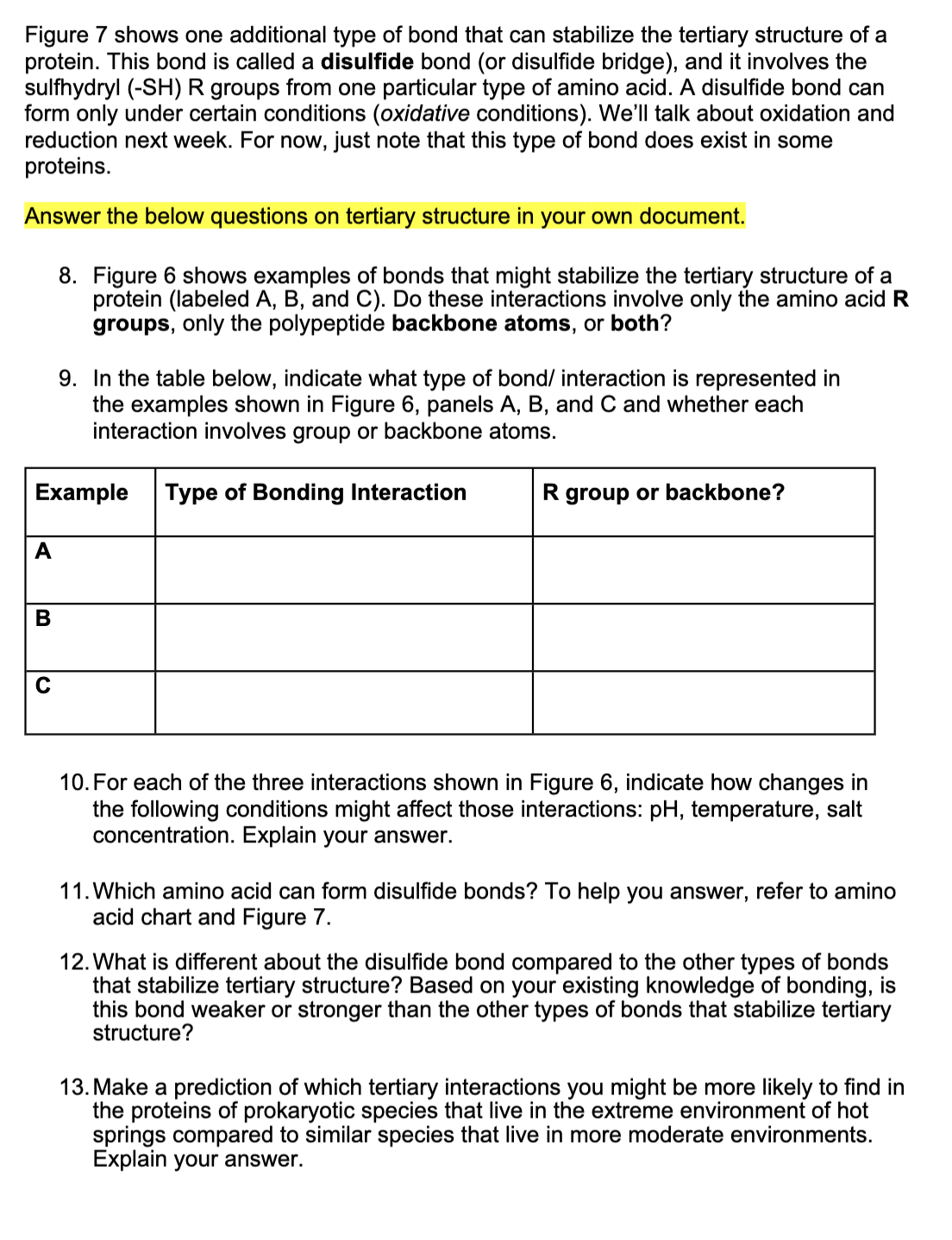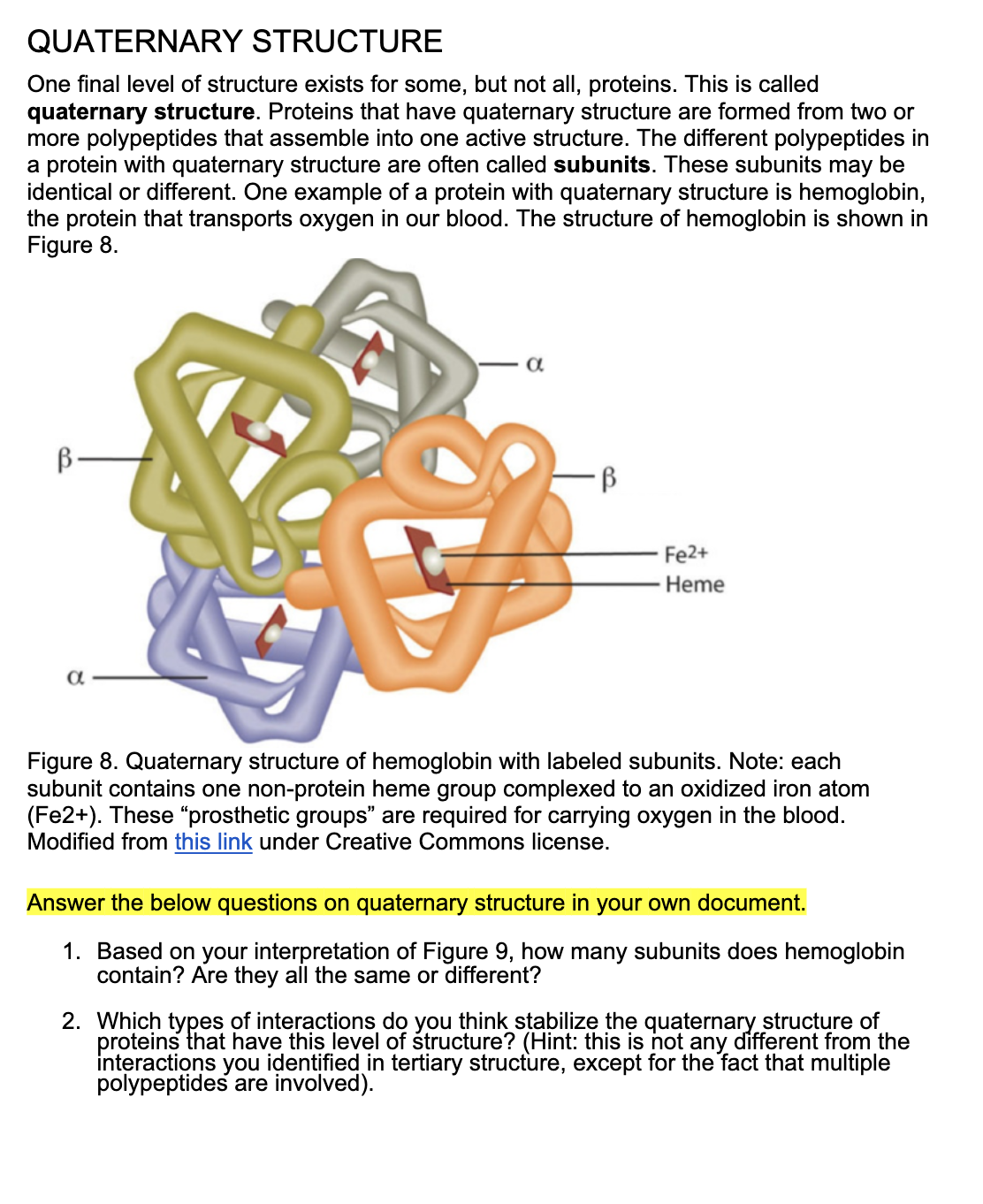Figure 8. B- Fe2+ - Heme Figure 8. Quaternary structure of hemoglobin with labeled subunits. Note: each subunit contains one non-protein heme group complexed to an oxidized iron atom (Fe2+). These “prosthetic groups" are required for carrying oxygen in the blood. Modified from this link under Creative Commons license. Answer the below questions on quaternary structure in your own document. 1. Based on your interpretation of Figure 9, how many subunits does hemoglobin contain? Are they all the same or different? 2. Which types of interactions do you think stabilize the quaternary structure of proteins that have this level of śtructure? (Hint: this is not any different from the interactions you identified in tertiary structure, except for the fact that multiple polypeptides are involved).
Figure 8. B- Fe2+ - Heme Figure 8. Quaternary structure of hemoglobin with labeled subunits. Note: each subunit contains one non-protein heme group complexed to an oxidized iron atom (Fe2+). These “prosthetic groups" are required for carrying oxygen in the blood. Modified from this link under Creative Commons license. Answer the below questions on quaternary structure in your own document. 1. Based on your interpretation of Figure 9, how many subunits does hemoglobin contain? Are they all the same or different? 2. Which types of interactions do you think stabilize the quaternary structure of proteins that have this level of śtructure? (Hint: this is not any different from the interactions you identified in tertiary structure, except for the fact that multiple polypeptides are involved).
Human Anatomy & Physiology (11th Edition)
11th Edition
ISBN:9780134580999
Author:Elaine N. Marieb, Katja N. Hoehn
Publisher:Elaine N. Marieb, Katja N. Hoehn
Chapter1: The Human Body: An Orientation
Section: Chapter Questions
Problem 1RQ: The correct sequence of levels forming the structural hierarchy is A. (a) organ, organ system,...
Related questions
Question

Transcribed Image Text:Figure 7 shows one additional type of bond that can stabilize the tertiary structure of a
protein. This bond is called a disulfide bond (or disulfide bridge), and it involves the
sulfhydryl (-SH) R groups from one particular type of amino acid. A disulfide bond can
form only under certain conditions (oxidative conditions). We'll talk about oxidation and
reduction next week. For now, just note that this type of bond does exist in some
proteins.
Answer the below questions on tertiary structure in your own document.
8. Figure 6 shows examples of bonds that might stabilize the tertiary structure of a
protein (labeled A, B, and C). Do these interactions involve only the amino acid R
groups, only the polypeptide backbone atoms, or both?
9. In the table below, indicate what type of bond/ interaction is represented in
the examples shown in Figure 6, panels A, B, and C and whether each
interaction involves group or backbone atoms.
Example
Type of Bonding Interaction
R group or backbone?
A
В
10. For each of the three interactions shown in Figure 6, indicate how changes in
the following conditions might affect those interactions: pH, temperature, salt
concentration. Explain your answer.
11. Which amino acid can form disulfide bonds? To help you answer, refer to amino
acid chart and Figure 7.
12. What is different about the disulfide bond compared to the other types of bonds
that stabilize tertiary structure? Based on your existing knowledge of bonding, is
this bond weaker or stronger than the other types of bonds that stabilize tertiary
structure?
13. Make a prediction of which tertiary interactions you might be more likely to find in
the proteins of prokaryotic species that live in the extreme environment of hot
springs compared to similar species that live in more moderate environments.
Explain your answer.

Transcribed Image Text:QUATERNARY STRUCTURE
One final level of structure exists for some, but not all, proteins. This is called
quaternary structure. Proteins that have quaternary structure are formed from two or
more polypeptides that assemble into one active structure. The different polypeptides in
a protein with quaternary structure are often called subunits. These subunits may be
identical or different. One example of a protein with quaternary structure is hemoglobin,
the protein that transports oxygen in our blood. The structure of hemoglobin is shown in
Figure 8.
B-
Fe2+
- Heme
a
Figure 8. Quaternary structure of hemoglobin with labeled subunits. Note: each
subunit contains one non-protein heme group complexed to an oxidized iron atom
(Fe2+). These “prosthetic groups" are required for carrying oxygen in the blood.
Modified from this link under Creative Commons license.
Answer the below questions on quaternary structure in your own document.
1. Based on your interpretation of Figure 9, how many subunits does hemoglobin
contain? Are they all the same or different?
2. Which types of interactions do you think stabilize the quaternary structure of
proteins that have this level of structure? (Hint: this is not any different from the
interactions you identified in tertiary structure, except for the fact that multiple
polypeptides are involved).
Expert Solution
This question has been solved!
Explore an expertly crafted, step-by-step solution for a thorough understanding of key concepts.
This is a popular solution!
Trending now
This is a popular solution!
Step by step
Solved in 2 steps

Recommended textbooks for you

Human Anatomy & Physiology (11th Edition)
Biology
ISBN:
9780134580999
Author:
Elaine N. Marieb, Katja N. Hoehn
Publisher:
PEARSON

Biology 2e
Biology
ISBN:
9781947172517
Author:
Matthew Douglas, Jung Choi, Mary Ann Clark
Publisher:
OpenStax

Anatomy & Physiology
Biology
ISBN:
9781259398629
Author:
McKinley, Michael P., O'loughlin, Valerie Dean, Bidle, Theresa Stouter
Publisher:
Mcgraw Hill Education,

Human Anatomy & Physiology (11th Edition)
Biology
ISBN:
9780134580999
Author:
Elaine N. Marieb, Katja N. Hoehn
Publisher:
PEARSON

Biology 2e
Biology
ISBN:
9781947172517
Author:
Matthew Douglas, Jung Choi, Mary Ann Clark
Publisher:
OpenStax

Anatomy & Physiology
Biology
ISBN:
9781259398629
Author:
McKinley, Michael P., O'loughlin, Valerie Dean, Bidle, Theresa Stouter
Publisher:
Mcgraw Hill Education,

Molecular Biology of the Cell (Sixth Edition)
Biology
ISBN:
9780815344322
Author:
Bruce Alberts, Alexander D. Johnson, Julian Lewis, David Morgan, Martin Raff, Keith Roberts, Peter Walter
Publisher:
W. W. Norton & Company

Laboratory Manual For Human Anatomy & Physiology
Biology
ISBN:
9781260159363
Author:
Martin, Terry R., Prentice-craver, Cynthia
Publisher:
McGraw-Hill Publishing Co.

Inquiry Into Life (16th Edition)
Biology
ISBN:
9781260231700
Author:
Sylvia S. Mader, Michael Windelspecht
Publisher:
McGraw Hill Education